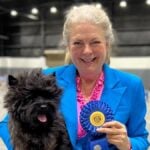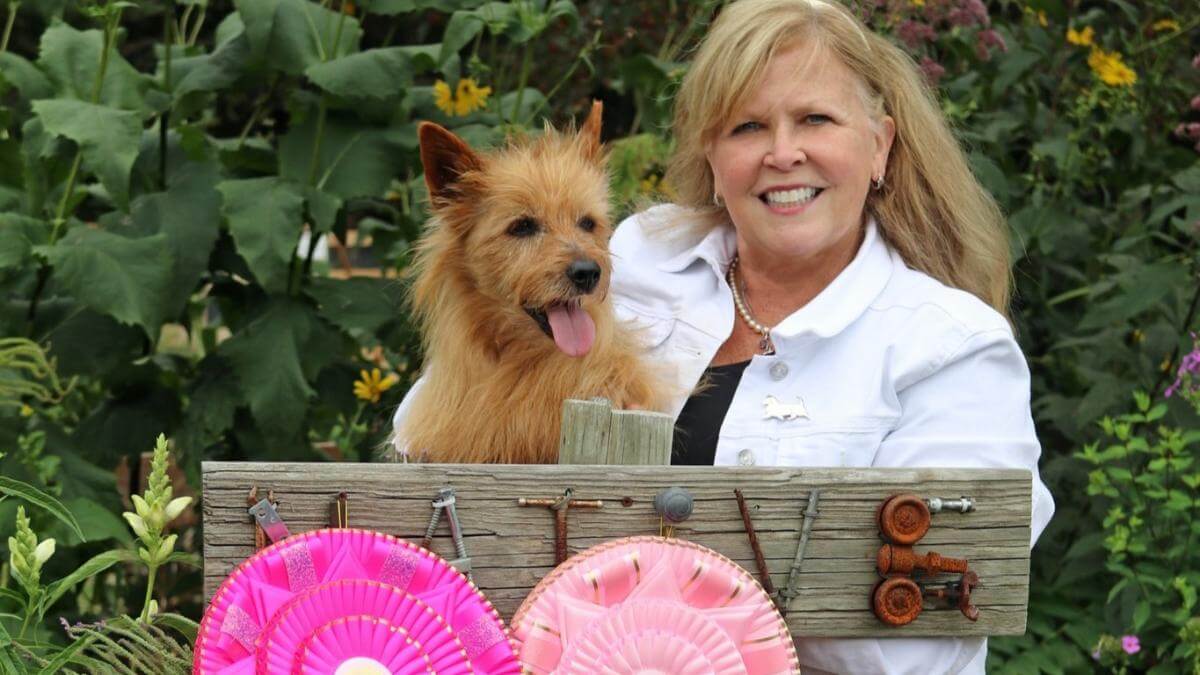
Home » Theresa Goiffon | Dunham Lake Australian Terriers

Theresa Goiffon
1. My name is Theresa Goiffon, and I live in Northwestern Wisconsin with my husband, Rich Goiffon. I have been involved in and/or breeding Australian Terriers with my daughters since 2007, under the kennel name Dunham Lake. I am a Multiple Best in Show breeder, an AKC (American Kennel Club) Silver Breeder of Merit, AKC Delegate, and the 2024 recipient of the AKC Outstanding Sportsmanship Award.
Most recently, I returned from the 2025 World Dog Show in Finland, where my young female and my bred-by, co-owned boy, OHBIS MROHBIS GCHB Dunham Lake The Heat Is On FCAT FTI, “Wasabi,”—who was, as always, beautifully handled by his owner Chris Chapman, (Heartland Australian Terriers)—were the only Australian Terriers representing the United States. Both were awarded Excellent. It was an extraordinary experience.
Outside of dogs, I enjoy spending time with our grandsons, canning, baking, and being a devoted servant to my beloved terriers.
2. Australian Terriers must be keen in expression, with almond-shaped eyes, pricked ears, and a sturdy, medium-boned frame—never large nor fine-boned. Their body should be longer than tall, with a distinctive ruff, apron, and soft topknot. A slightly arched, strong neck should blend into a well-laid-back shoulder. The muzzle must be strong and powerful, with fill under the eyes.
Equally important is temperament: spirited, alert, courageous, and an aggressive hunter, yet also a devoted family companion, wonderful with children.
Movement is critical. Correct Australian Terriers move in planes parallel to the centerline of travel, with reach and drive, while maintaining a firm, level topline. Unfortunately, too many are being rewarded in the show ring without this essential quality, which undermines breed function.
After attending the 2025 World Dog Show, it was inspiring to see so many correct Australian Terriers overseas. Here in the US, we breeders must do better. My advice to judges, who may not see the breed often: Remember, they are not heavy-boned, not square-bodied, and above all, they must be able to move.
3. As a rare breed, Australian Terriers still lack exposure and public awareness. I am often asked, “Is that a large Yorkie?” While no offense is meant to the adorable Yorkshire Terrier, this question gives me the chance to educate.
I typically breed two litters or fewer per year, and I almost always have a waiting list with puppies pre-placed. I usually retain one for myself or for a future show/breeding home. While my waiting lists are shorter than they once were, this is not due to cost or the fact that I do not ship; it is simply because the breed remains relatively unknown.
4. Health and longevity are priorities for me. While Australian Terriers are generally quite healthy, I utilize DNA testing when needed and keep abreast of ongoing studies and diagnostics to inform breeding decisions.
In communications, I maintain a strong online presence through my website and social media, both to educate and to connect with prospective owners. I created several Facebook groups: Australian Terrier Health Group (focused on health, diet, and grooming), Australian Terrier Tales (a fun storytelling and photo-sharing group), and Tales of Judging Tails, a large community that supports Conformation exhibitors with natural, undocked dogs. I stopped docking my own dogs 14 years ago, and this group has been an important resource for like-minded breeders across all breeds.
5. Not significantly. For over 20 years, the uninformed perception has persisted that purebred dogs are “bad,” while adopting and purchasing doodle mixes is “good.” Unfortunately, this misunderstanding is widespread. While I don’t have the answer to changing this mindset, I believe it’s our responsibility to continue educating the public about the value of purebred dogs.
6. One concern is the lack of young people entering the sport. Dog shows are expensive and time-consuming, which can discourage newcomers. Another concern is that some exhibitors do not take advantage of opportunities to engage with the public at shows. Each show is an educational platform—we must be approachable and willing to share knowledge about our breeds.
7. One of the most positive changes I’ve noticed is the increased emphasis on health testing and responsible breeding practices across many breeds. More breeders are embracing genetic tools, sharing data, and openly discussing health issues, which I believe benefits the future of our sport and our dogs.
Another encouraging development is the growth of online communities that support education and mentorship. Social media, while sometimes challenging, has allowed breeders and exhibitors worldwide to connect, share knowledge, and celebrate achievements together. This sense of global connection strengthens our passion and helps smaller breeds like the Australian Terrier gain visibility.
Finally, I am heartened by the increasing support for preserving natural dogs in the show ring. As more judges and exhibitors welcome tailed and undocked dogs, the sport is becoming more inclusive and more closely aligned with international Standards. These positive steps give me hope for the future of purebred dogs and the sport we all love.